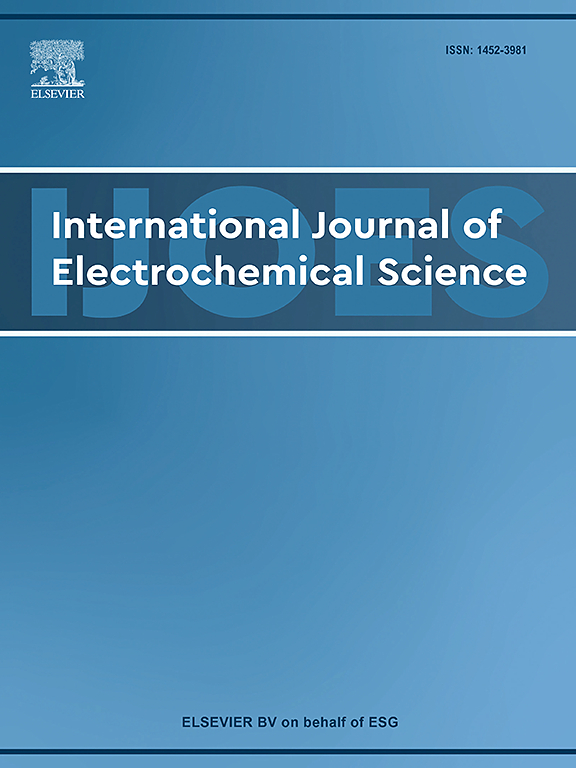Numerical simulation for a suitable electron transport layer of a lead-free CuInSe2 based perovskite solar cell and PV module
IF 1.3
4区 化学
Q4 ELECTROCHEMISTRY
International Journal of Electrochemical Science
Pub Date : 2025-01-01
DOI:10.1016/j.ijoes.2024.100893
引用次数: 0
Abstract
The high expense of solar cell manufacture and experimentation has led researchers to use numerical simulation. The advantages of simulation-based optimization include the simplicity of use, low cost, and the ability to forecast the ideal parameters that go into producing a cell with the optimum performance. The efficiency of perovskite materials used in solar systems has increased significantly, and they are virtually ready for commercialization. Academics and the scientific community are now interested in lead-free perovskite materials because of the toxic problem and hazardous nature of lead (Pb)-based perovskite materials. In this research, Pb is replaced by copper indium diselinide (CuInSe2). This study simulated, examined, and analyzed the performance of photovoltaic (PV) CuInSe2-based TFSCs with three different electron transport layers: indium sulfide (In2S3), titanium dioxide (TiO2), and stannic oxide (SnO2). SCAPS-1D software was used to model (FTO/TiO2/CuInSe2/Spiro-OMeTAD/Ni), (FTO/SnO2/CuInSe2/Spiro-OMeTAD/Ni), and (FTO/In2S3/CuInSe2/Spiro-OMeTAD/Ni) configurations to determine which one has the highest conversion efficiency. All three electron transport layer (ETL) thicknesses, with absorber and hole-transport (HTL) layer thicknesses, were optimized. Results indicate that, the absorber layer for SnO2 and In2S3 layers must be 3.00 µm thick, and for the TiO2 layer it must be 4.00 µm thick. Efficiency of 26.17 % is revealed with SnO2, whereas Jsc, Voc, and FF, are observed as 43.15 mA/cm2, 0.723 V, and 83.80 %, respectively. While with In2S3, efficiency is revealed as 26.15 %, with Jsc, Voc, and FF are observed as 43.17 mA/cm2, 0.723 V, and 83.68 % respectively. Efficiency of 26.65 % is revealed by TiO2 with current density (Jsc), open circuit voltage (Voc), and fill factor (FF), which are shown as 43.53 mA/cm2, 0.728 V, and 83.68 %, respectively which was carefully calculated. The device shows highest performance with TiO2 ETL. The maximum extent for Jsc, Voc, FF%, and PCE% during optimal investigation is shown by the generation of supplemental electron-hole pairs under standard conditions by altering the thicknesses of the absorber, hole, and electron transport layers. Parasitic resistances effect on the cell performance indicate that solar cells work effectively with low Rs and high Rsh values. The temperature effect on solar cells shows that as temperature rises, cell performance declines due to increased reverse saturation current and reduced bandgap. Quantum efficiency analysis of three ETL layers found that TiO2 and SnO2 efficiency increased rapidly between 300–400 nm, while In2S3 peaked at 300 nm and then declined. Simulation results from SCAPS-1D were used to configure PVsyst software for a solar module with 72 cells (2.2 ×1.1 m). Module performance and output power were evaluated based on temperature and sun irradiation variations using input from the solar capacitance simulator. The potential of CuInSe2 as a perovskite material to produce toxicity-free renewable energy is demonstrated by this study.
求助全文
约1分钟内获得全文
求助全文
来源期刊
CiteScore
3.00
自引率
20.00%
发文量
714
审稿时长
2.6 months
期刊介绍:
International Journal of Electrochemical Science is a peer-reviewed, open access journal that publishes original research articles, short communications as well as review articles in all areas of electrochemistry: Scope - Theoretical and Computational Electrochemistry - Processes on Electrodes - Electroanalytical Chemistry and Sensor Science - Corrosion - Electrochemical Energy Conversion and Storage - Electrochemical Engineering - Coatings - Electrochemical Synthesis - Bioelectrochemistry - Molecular Electrochemistry

 求助内容:
求助内容: 应助结果提醒方式:
应助结果提醒方式:


